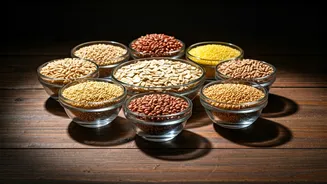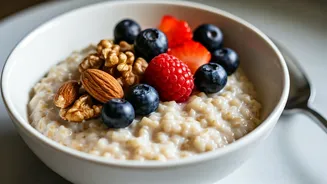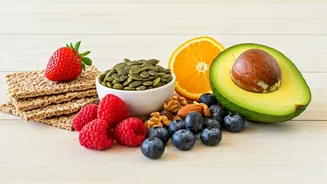Embracing Low-GI Foods
Understanding the Glycemic Index (GI) is crucial for managing blood sugar and weight. The GI measures how quickly a food raises blood glucose levels. Low-GI
foods are digested and absorbed more slowly, preventing rapid spikes in blood sugar. This is particularly beneficial for people with diabetes, as it helps them maintain stable glucose levels, reducing the risk of complications. Weight management is also positively impacted because low-GI foods often promote satiety, helping individuals feel fuller for longer, which can reduce overall calorie intake. By focusing on low-GI options, individuals can make informed dietary choices that support their health goals and enhance their well-being. This approach offers a practical and effective way to manage health through dietary adjustments and proactive choices.
Barley: A Nutrient Powerhouse
Barley is a fantastic low-GI grain loaded with soluble fiber, especially beta-glucan. This fiber slows glucose absorption and helps lower cholesterol levels, contributing significantly to heart health. It also offers a hearty, satisfying texture, making it an excellent base for soups, stews, and salads. Barley provides a sustained release of energy, preventing the energy crashes often associated with high-GI foods. Its versatility allows for easy incorporation into a range of meals, supporting both diabetes management and weight control through a nutrient-dense and satisfying food source. Including barley in your diet can be a delicious and effective step towards better health.
Quinoa: The Versatile Seed
Quinoa, though technically a seed, is often used as a grain and is a complete protein source, offering all nine essential amino acids. Its low GI makes it a great choice for blood sugar management. Quinoa's high fiber content aids digestion and promotes satiety. It is also packed with essential vitamins and minerals, supporting overall health. Its nutty flavor and fluffy texture make quinoa a versatile ingredient suitable for various dishes, from salads to breakfast bowls. Choosing quinoa over higher-GI grains can improve blood sugar control and provide a wealth of nutrients, making it a valuable addition to any healthy diet plan.
Oats: A Heart-Healthy Choice
Oats, especially the rolled or steel-cut varieties, have a low GI and are rich in soluble fiber, especially beta-glucan. This fiber assists in slowing down the absorption of glucose, which is crucial for managing blood sugar levels. They are known for their heart-health benefits, aiding in lowering cholesterol and supporting overall cardiovascular health. Oats provide a sustained release of energy, which helps you feel full longer and prevents hunger pangs. Their flexibility in cooking, suitable for breakfast porridge, baked goods, or savory dishes, makes them an easy and beneficial addition to a balanced diet, helping to control blood sugar and support weight management.
Buckwheat: A Gluten-Free Option
Buckwheat (kuttu), despite its name, is not related to wheat and is a gluten-free grain with a low GI. It's rich in fiber and beneficial nutrients like magnesium, which can improve insulin sensitivity, supporting better blood sugar control. Buckwheat can be used in various ways, such as in pancakes, noodles, or porridge, making it an adaptable ingredient for diverse diets. Buckwheat provides a good source of complex carbohydrates, releasing energy slowly to prevent significant blood sugar fluctuations. For those seeking gluten-free alternatives or wanting to manage their blood sugar, buckwheat is a beneficial and flexible addition to the diet.
Brown Rice: A Healthy Staple
Brown rice is a whole-grain option with a lower GI than white rice, providing more fiber and nutrients. This fiber assists in slowing down glucose absorption, which is advantageous for stable blood sugar levels. Brown rice is also rich in magnesium, an essential mineral for insulin function. It adds a nutty flavor and satisfying texture to meals. Whether as a side dish, in salads, or as a base for stir-fries, brown rice offers a practical and healthy choice for both managing diabetes and supporting weight management. It's a versatile staple that can contribute to a balanced and health-conscious diet plan.
Bulgur: A Quick-Cooking Choice
Bulgur, made from parboiled wheat, is a whole-grain food with a low to moderate GI. It is a good source of fiber, which helps regulate blood sugar and promotes digestive health. Bulgur is known for its quick cooking time and is versatile, suitable for salads, pilafs, and stuffings. It provides a satisfying texture and mild flavor, making it a valuable ingredient in a variety of dishes. Due to its fiber content and moderate GI, bulgur can be included in a diet designed for diabetes management and weight control. Its versatility and ease of preparation make it an accessible option for those seeking healthier grain choices.
Millet: An Ancient Grain
Millet, an ancient grain, has a low GI and is naturally gluten-free. It's a good source of fiber, magnesium, and other essential nutrients, which support healthy blood sugar control and overall well-being. Millet can be used in various culinary applications, from porridge to side dishes, offering a mild, slightly sweet flavor. It provides a sustained energy release, making it a satisfying and healthy option for meals. Millet is a beneficial choice for individuals with diabetes and those seeking to manage their weight. Its versatility and nutritional value make it a valuable addition to a diverse and healthy diet.
Amaranth: A Complete Protein
Amaranth is a small, gluten-free grain with a low GI, providing a complete protein source, offering all nine essential amino acids. It's rich in fiber, which aids in stable blood sugar levels, and is packed with essential nutrients like manganese. Amaranth can be used in various ways, such as in porridge, salads, or as a flour for baking. It adds a slightly peppery flavor and pleasant texture to dishes. By including amaranth in your diet, you can benefit from its nutrient density and contribution to blood sugar control. For those looking for gluten-free options and comprehensive nutrition, amaranth is an excellent choice.
Whole-Wheat Pasta: A Smart Swap
Whole-wheat pasta, made from whole-wheat flour, has a lower GI than refined pasta, offering more fiber and nutrients. The higher fiber content assists in slowing down the absorption of glucose, which is crucial for managing blood sugar levels. It provides a sustained release of energy, keeping you feeling full longer and preventing energy crashes. This pasta is also rich in essential nutrients, supporting overall health and well-being. Switching to whole-wheat pasta is an easy dietary adjustment that can contribute to improved blood sugar control and weight management, allowing you to enjoy your favorite dishes while prioritizing your health.













